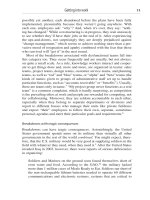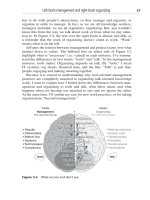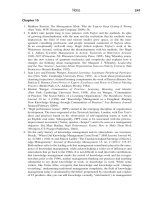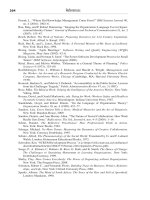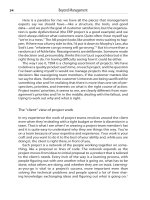Factors affect taking charge at vingroup corporation
Bạn đang xem bản rút gọn của tài liệu. Xem và tải ngay bản đầy đủ của tài liệu tại đây (1.26 MB, 59 trang )
RESEARCH PROJECT
(BMBR5103)
FACTORS AFFECTING TAKING CHARGE
AT VINGROUP CORPORATION
STUDENT’S FULL NAME
STUDENT ID
INTAKE
ADVISOR’S NAME & TITLE
: NGUYEN DINH NHU HA
: CGS00018247
: MAY 2014
: NGUYEN THE KHAI (DBA)
August, 2015
ADVISOR’S ASSESSMENT
.......................................................................................................................................................
.......................................................................................................................................................
.......................................................................................................................................................
.......................................................................................................................................................
.......................................................................................................................................................
.......................................................................................................................................................
.......................................................................................................................................................
.......................................................................................................................................................
.......................................................................................................................................................
.......................................................................................................................................................
.......................................................................................................................................................
.......................................................................................................................................................
.......................................................................................................................................................
.......................................................................................................................................................
.......................................................................................................................................................
.......................................................................................................................................................
.......................................................................................................................................................
ADVISOR’S SIGNATURE
NGUYEN THE KHAI (DBA)
Research Project
-
Student: Nguyễn Đình Như Hà
1
ACKNOWLEDGEMENTS
Truthfully speaking, I would like to acknowledge the assistance of individuals who
guide and help me for completing this research. Firstly of all, I am very grateful to
professor Dr. Khai Nguyen. I would like to send truthful thanks to Dr. Khai Nguyen for
the patience, time, comments and support me during the research.
Besides, I would like to thank to the board of managers and all employees of Vingroup
Corporation for their precious comments and helps to collect data for this thesis.
I also wish to give my sincerest and deepest gratitude to my family and all of my
sweet friends for their encouragement, and great support.
With best regards
Ho Chi Minh City, August 2015
Research Project
-
Student: Nguyễn Đình Như Hà
2
TABLE OF CONTENTS
Abstract ............................................................................................................... page 5
Chapter 1: Introduction
1. Company Brief introduction ............................................................................ page 6
2. Organizational Structure of Vingroup ............................................................ page 10
3. Corporate Culture of Vingroup ...................................................................... page 11
4. Motivation of The Research ........................................................................... page 12
5. Research Problem Statements ........................................................................ page 13
6. Purpose of The Research ................................................................................ page 13
7. Scope of The Research ................................................................................... page 14
8. Significance of The Research ......................................................................... page 14
9. Limitation of The Research ............................................................................ page 14
Chapter II: Literature Review
1. Job Demand and Decision Latitude ............................................................... page 15
2. Supervisory Support ....................................................................................... page 16
3. Distributive and Procedural Justice ................................................................ page 17
4. Organizational Commitment .......................................................................... page 20
5. Taking Charge ................................................................................................ page 21
Chapter III: Research model and hypotheses
1. Research Model .............................................................................................. page 23
2. Hypotheses ...................................................................................................... page 24
2.1. Job characteristics .................................................................................... page 24
Research Project
-
Student: Nguyễn Đình Như Hà
3
2.2. Organizational Commitment .................................................................... page 26
2.3. Organizational Justice .............................................................................. page 28
2.4. Workplace Behaviors ............................................................................... page 31
3. Research Participants ..................................................................................... page 34
4. Data Collection Procedure ............................................................................. page 34
Chapter IV: Analysis and results
1. Cronbach’s Alpha ........................................................................................... page 35
2. Descriptive Statistic ....................................................................................... page 36
3. Hypothesis Testing
3.1. Hypothesis 1 Testing Results ................................................................... page 36
3.2. Hypothesis 2 Testing Results ................................................................... page 37
3.3. Hypothesis 3 Testing Results ................................................................... page 38
3.4. Hypothesis 4 Testing Results ................................................................... page 39
Chapter V: Conclusion
1. Summary of The Results ................................................................................ page 40
2. Discussion and Recommendation .................................................................. page 40
3. Limitation ....................................................................................................... page 42
References ......................................................................................................... page 43
Appendix
Appendix 1: Survey Questionnaire ..................................................................... page 46
Appendix 2: Presentation Slides ......................................................................... page 51
Research Project
-
Student: Nguyễn Đình Như Hà
4
FIGURES AND TABLES
Figures
Figure 1: Vingroup’s Corporate Structure ......................................................... page 11
Figure 2: Hypothesized Research Model ........................................................... page 24
Tables
Table 1: Vingroup’s Profile ................................................................................. page 9
Table 2: Data Collection Process ....................................................................... page 35
Table 3: Cronbach’s Alpha – Internal Consistency ........................................... page 36
Table 4: Cronbach’s Alpha of all Variables ....................................................... page 36
Table 5: Descriptive Statistics ............................................................................ page 37
Table 6: Model Summary (H1) .......................................................................... page 37
Table 7: Coefficients (H1) ................................................................................. page 38
Table 8: Model Summary (H2) .......................................................................... page 38
Table 9: Coefficients (H2) ................................................................................. page 38
Table 10: Model Summary (H3) ........................................................................ page 39
Table 11: Coefficients (H3) ............................................................................... page 39
Table 12: Model Summary (H4) ........................................................................ page 40
Table 13: Coefficients (H4) ............................................................................... page 40
Table 14: Summary of Hypothesis Testing Results ........................................... page 40
Research Project
-
Student: Nguyễn Đình Như Hà
5
ABSTRACT
Factors impacting on the willingness of employees’ taking charge are considered to be
very important and vital for the improvement and success of any organizations. In this
study, I suppose that Job Demand and Decision Latitude, Supervisory Support,
Distributive and Procedural Justice, and Organizational Commitment are significant
factors that affect Vingroup’s employees’ Taking Charge. The results based on the data
collected from 250 employees at Vingroup largely supported the proposed theoretical
framework. The findings in this study are expected to assist Vingroup managers to have
more sharpened and effective strategies for the process of developing the Group as well
as improving the management of human resource.
Key words: Job Demand and Decision Latitude, Supervisory Support, Distributive and
Procedural Justice, Organizational Commitment, Taking Charge.
Research Project
-
Student: Nguyễn Đình Như Hà
6
CHAPTER I: INTRODUCTION
1. Company Brief Introduction
Vingroup
Joint
Stock
Company
(“Vingroup”) is a leading private economic
corporation in Vietnam, engaging in the fields of
tourism and high-end real estate with two
strategic brands, Vinpearl and Vincom.
Joining in the market in 2002, Vincom spared no efforts to become Vietnam’s
premier upmarket real estate brand with a number of shopping mall, office and apartment
complexes, and large-scale modern mixed-use townships, spearheading the trend of
high-end ecological urban zones in Vietnam. In the current downturn economy,
Vingroup’s projects still stand out from the market thanks to the Group’s commitment
to progress and quality, which has established its strong brand and excellent reputation.
After joining the market in 2001, Vingroup’s hospitality brand, Vinpearl, soon
became the flagship of the Vietnamese tourism sector, featuring five-star and five-star
plus hotel and resorts, as well as beachfront villas, amusement parks and golf courses
under the Vinpearl Resort, Vinpearl Luxury and Vinpearl Villas brands. Vingroup also
aims to develop ten hotel, resort and recreation complexes at the most popular tourist
destinations in Vietnam over the next half-decade.
In addition to the two above-mentioned strengths, Vingroup has recently begun
operating top quality healthcare, and fitness and beauty care facilities under two new
strategic brands, Vinmec and Vincharm. The first Vinmec International Hospital in
Hanoi, featuring 600 single in-patient rooms and clinics, was officially inaugurated in
January 2012.
Vingroup has always played the role of the pioneer and driver of consumer trends
in all its business sectors through offering top quality and five-star international standard
products.
Research Project
-
Student: Nguyễn Đình Như Hà
7
In January 2012, Vinpearl JSC was merged into Vincom JSC, marking the official
operation of Vingroup Joint Stock Company, ranking among the top major companies
on Vietnam’s stock market in terms of market capitalization. The new structure ensures
sustained development and allows Vingroup to focus on developing its strategic brands:
• Vinhomes (Luxury serviced apartments and villas)
• Vincom (Premium shopping malls)
• Vinpearl (Hotels & Resorts)
• Vinpearl Land (Entertainment)
• Vinmec (Healthcare services)
• Vinschool (Education)
• VinEcom (E-commerce)
• Vincom Office (Offices for lease)
• Vinmart (Supermarket)
• Vinfashion (Fashion)
• Vincharm (Fitness and beauty care)
• Almaz (The International Cuisine & Convention Center)
• VinPro
Vingroup is also known on the international capital market as the first Vietnamese
enterprise to have successfully issued international convertible bonds listed on the
Singapore Exchange (SGX). By 2012, the Group had raised a total of US $400 million.
Operating with four strategic brand names: Vincom, Vinpearl, Vinmec and Vincharm,
owing and controlling interest in numerous high-end real estate and tourism projects,
Vingroup has become one of the leading private economic groups in Vietnam, boasting
Research Project
-
Student: Nguyễn Đình Như Hà
8
dynamic and sustainable growth as well as significant potential for integration into Asia
and the world.
CORPORATION’S PROFILE
Corporate’s English name
Vingroup Joint Stock Company
No.7, Bang Lang Street, Viet Hung Ward, Long
Head office
Bien District, Hanoi
Phone – Website
+84 4 39749999 – www.vingroup.net
Table 1: Vingroup’s profile
Vision
Guided by its pioneering aspirations as well as a sustainable investment - development
strategy, Vingroup has been striving to become Vietnam’s and the regions’ leading
multisectoral business group, which aims to become a Group of international stature and
standards.
Vingroup aspires to establish its Vietnamese brand, demonstrating Vietnamese
intellectual prominence and pride in the international arena.
Missions
For the market: To provide premium products and services of international standards
that are original, highly creative and embedded with local identities. In addition to its
outstanding quality, each product - service contains a cultural message with a view to
best cater for customers’ legitimate needs.
For shareholders and partners: To enhance the collaborative spirit for mutual
development; to strive to become “The Number 1 companion” of partners and
shareholders; to generate attractive and sustainable investment values for shareholders
and partners.
Research Project
-
Student: Nguyễn Đình Như Hà
9
For employees: To develop a professional, dynamic, creative and humane working
environment, enabling high income and equal development opportunities for all
employees.
For society: To harmonize the company’s and society’s benefits; to make active
contributions to community-oriented activities, and to demonstrate citizens’ sense of
responsibilities and national pride.
Core values
“Trust – Responsibility – Knowledge – Speed – Quality – Humanity”
Trust: to put a premium on Trust and protect Trust as protecting its pride, always be
well-prepared for execution and spare no effort for honoring its commitments.
Responsibility: to take Responsibility as a foundation, to strictly observe the law and
maintain ethics, to be committed to a customer-centric policy.
Knowledge: to highly value creativity as vitality and development leverage, to
appreciate courage and determination, to advocate the building of a “learning
business”.
Speed: to set the principle “Speed and efficiency in every activity”, to practice “quick
decision – quick investment – quick execution – quick sale and quick adaptation”.
Quality: to pursue the goal of “Quality personnel, quality products/services, and
quality life and quality society”.
Humanity: to develop relationships based on the spirit of humanity and treating staff
as the most treasured asset, to build “mildness” based on fairness, honesty and
solidarity.
Research Project
-
Student: Nguyễn Đình Như Hà
10
2. Organizational Structure of Vingroup
Figure 1: Vingroup’s corporate structure
Research Project
-
Student: Nguyễn Đình Như Hà
11
3. Corporate Culture of Vingroup
Vingroup brings together the most capable Vietnamese and international
professionals who possess intellect and discipline, talent and determination, patriotism
and ethnic pride, charity, good intentions and intense work ethics.
Each Vingroup employee must be proactive, eager to learn, constantly strive for
self-improvement and internalize the Group’s culture and its six core values as a
guideline for his or her actions.
Innovation must be constant and continuous to accomplish the goals of "Best
People - Best Products & Services - Best Life - Best Society". With each passing day,
all across Vietnam, day and night, rain or shine, projects bearing the Vingroup brand
continue to rise. This non-stop effort is to ensure sustained development of the Group
and bring future generations a better life.
With the utmost respect for discipline, Vingroup's corporate culture - a culture of
professionalism and trust is built on the six core values: "Credibility - Integrity Creativity - Speed - Quality - Humanity". The emphasis on speed, efficiency and
adherence to company policies is imbued in all employee actions, creating a collective
force that ensures strong success and development in all sectors in which the Group
participates.
The Group applies its determination and passion not only in the workplace, but
also in its cultural and community activities. To promote the "Healthy Body - Happy
Spirit – Nimble Mind" campaign, each Friday afternoon the company organizes a
“Healthy Living Festival” where employees participate in active entertainment activities
such as Flash mob dancing and intramural sports such as volleyball, soccer and tennis.
To instil and reinforce the six core values, the Group holds award contests and
training campaigns such as "Good People, Good Deeds", "Efficiency, Profitability" and
Research Project
-
Student: Nguyễn Đình Như Hà
12
"12-Hour Transformation for Success". These campaigns entertain, boost morale and
reinforce the core values while helping employees to change their thinking and work
more efficiently with better results.
For timely dissemination of corporate information as well as activities taking
place across the country, an internal magazine called "The House of Vingroup" provides
common space for employees to exchange ideas and to learn about and gain pride in the
history of the Group.
At Vingroup, each employee considers the Group a second home, a place to
engage and spend the majority of each day to live and work. In any role and any position,
we are proud to be a member of the Vingroup family.
4. Motivation of The Research
As it is known, Vietnam is a developing country with a potential variety of
businesses as well as potential competition of domestic and foreign firms. As a fact of
increasing living standard, more and more organizations are taking part in the service
sector. This type of sector has been merging in Vietnam recently and as it is said by
World Bank that Vietnam’s service sector has emerged as the largest sector in the
economy and the biggest contributor to the overall growth rate. Vingroup is one of the
largest firms in Vietnam taking advantages of people’s increasing needs to expand and
develop its business sectors.
The success of Vingroup in service sector has been confirmed by successful
projects in retailing, tourism, real estate and health care services. Without a doubt, with
the fast and stable development, Vingroup can be proud to say that it has a dedicated and
professional staffs. However, to effectively survive on the aggressive market, Vingroup
needs to consolidate and sharpen its employees for the process of conquering the market.
More specifically Vingroup needs to pay attention to factors affecting the employee’s
Research Project
-
Student: Nguyễn Đình Như Hà
13
taking charge at work. As it is said men and woman want to do a good job, and if they
are provided with proper environment, they will do so (Bill Hewlett, 2001).
5. Research Problem Statements
With the stable development of Vingroup, human resources are regarded to be a
valuable assets. Therefore, retaining and developing the staff is the first priority that
Vingroup needs to pay attention to and try its best for the process of conquering the
Vietnamese market.
In the aggressive market, Vingroup is competing with large competitors not only
domestic firms but also foreign competitors who have power and prestige on the market
like Lotte Group, Maximark, Big C, Satramart and so on.
As the result of aggressive competition in the industry, Vingroup needs a skilled
and dedicated staff who are willing to adopt changes and do their bests without the orders
from the Board of Directors. However, there is a fact that a number of employees
working at Vingroup are tending to reject changes and not willing to complete their
responsibilities for the following reasons:
- They are afraid of changing their traditional working habits.
- They are afraid of learning and adopting new procedures at work.
- They don’t receive thoughtful cares from the Board of Directors.
- Even though they work in an active and professional working environment, they are
sometime unfairly treated.
- Some employees aren’t willing to dedicate their skills, knowledge and physical health
to the development of the Group.
6. Purpose of The Research
The purpose of the study is to examine the factors like Job Demand and Decision
Latitude, Supervisory Support, Distributive and Procedural Justice, and Organizational
Commitment related to the willingness of employees’ Taking Charge at work.
Research Project
-
Student: Nguyễn Đình Như Hà
14
With the findings from the study, it is expected to give empirical evidences in the
aspects of how these factors impacting on the taking charge of employees and in what
way the Board of Directors can help to improve these factors. Last but not least, it is
expected from the study that the findings and results will help to improve policies so that
employees can have more professional working environment.
7. Scope of The Research
The research was conducted on 250 employees who are currently working at the
Group. The questionnaires were sent to the employee in 25 days to fill in.
8. Significance of The Research
The research is conducted to give the Board of Directors a deep understanding of
factors impacting on the employee’s taking charge. In addition, as it is mentioned above,
the research will help the Board of Directors have a clearer view of problems that are
causing the employees not willing to adopt changes and dedicate to the work.
9. Limitations of The Research
Conducted in three days at Vingroup with just 250 employees, the research cannot
have overall and specific views of most of employees. Besides that Vingroup is operating
with lots of branches all over Vietnam. Properly speaking, working condition in some
areas can cause employees have different viewpoints.
Unexpected limitations can cause the problems for the findings to be correct and
more meaningful. These ones can be time, physical condition of employees. However,
with the hope to find out the viewpoints of employees to help the Group to develop much
more in the future.
Research Project
-
Student: Nguyễn Đình Như Hà
15
CHAPTER II: LITERATURE REVIEW
1. Job Demand and Decision Latitude
Well-known organizational case studies have indirectly referred to the important
interactive effects of job demands and job decision latitude. Whyte’s restaurant workers
(1948) experienced the severest strain symptoms when they faced heavy customer
demands which they were not able to control. Gouldner (1954) notes that personal and
organizational tensions increase when close supervision is applied to miners under heavy
workloads; and Crozier (1964) and Drabek and Hass (1969) discuss organizational strain
which arises among groups of workers simultaneously facing heavy workloads and rigid
rule structures of limited decision alternatives. Unfortunately, these case studies and their
consistent findings have had little influence on survey analyses of mental strain among
large group of working individuals.
Research traditions have emerged to deal with the psychosocial effects of work
environments. One tradition focuses on job decision latitude (decision authority or skill
level), the other treats “stressors” on the job. Most of the vast literature on job satisfaction
and mental strain focuses primarily on job decision latitude (for example, Kornhauser,
1965; even Hackman and Lawler, see p.290), while the “life stress” tradition of
epidemiological studies of mental health (for example, Holmes and Rahe, 1967;
Dohrenwend and Dohrenwend, 1974) focuses on the illnesses induced by environmental
stressors or job stressors along (for example, Sundbom, 1971; Caplan et al., 1976;
Theorell, 1976). Unfortunately, job decision latitude research rarely includes systematic
discussion of job demand and the job demand literature rarely includes systematic
discussion of decision latitude (Karasek, 1978a).
Karasek (1979) defined “decision latitude” as “the working individual’s potential
control over his tasks and his conduct during the working day” (pp.289-290). This factor
has frequently been shown to influence aspects of employee well-being and physical
health; for example, reviews by Ganster and Fusilier (1989). Parkes (1989), and Warr
Research Project
-
Student: Nguyễn Đình Như Hà
16
(1987), Karasek also drew attention to the importance of job demands, these being
defined as “psychological stressors involved in accomplishing the work load” (p.291).
He demonstrated through secondary analyses of data from the USA and Sweden that
variables such as job satisfaction, exhaustion, and depression could be predicted from
the combination of these two job characteristics. Specifically, he found that employee in
jobs perceived to have both low decision latitude and high job demands were particularly
likely to report low well-being.
2. Supervisory Support
Supervisory support is often defined as the extent to which supervisors encourage
employees to attend training and apply the training on the job (Facteau et al., 1995;
Switzer, Nagy & Mullins, 2005). The burgeoning literature suggests that support
emanating from the supervisors play an important function in promoting transfer of
training (Baldwin & Ford, 1988; Elangovan & Karakowsky, 1999; Nikandrou, Brinia &
Bereri, 2009).
Colquitt et al. (2000), in their quantitative review on factors affecting training
motivation and transfer outcomes based upon 106 articles published since 1975, found
similar result. They posited that the extent to which supervisors provided sufficient
support had robustly correlated with the employees’ ability to transfer what they learned
on the job. The meta-analytic study was fully supported by other comprehensive reviews
of training transfer literature (e.g., Elangovan & Karakowsky, 1999; Cheng & Ho, 2001;
Merriam & Leahy, 2005; Burke & Hutchins, 2007).
Many researches have scrutinized the importance of supervisor support and found
that employees also expect supervisors to be caring and supportive (Eisenberger et al.,
2002; Kottke and Sharafinski, 1988). Griffton et al., (2001) found that supervisor’s
support have strong relationship with job satisfaction and Ogilvie (1986) confirmed that
supervisors’ actions directly impact the commitment of employees. Armstrong-Stassen
(1998) proved that organizational support has more impact on organizational
Research Project
-
Student: Nguyễn Đình Như Hà
17
commitment. Hutchison, (1997) concluded that although both organizational support and
supervisor support have positive effect on organizational commitment, organizational
support will help employees more.
Also, Xiao (1996) conducted a quantitative study on transfer of training based on
a sample of 1023 women employees working in four electronic manufacturing
companies located at Shenzhen, China. Through the analysis of survey results, the
researcher discovered that support from supervisors was the most influential factor that
correlated with transfer of training.
Janssen (2003) found evidence that employees responded more innovatively to
higher levels of job demands when they perceived that their efforts were fairly rewarded
by their supervisor. Oldham and Cummings (1996) found that supportive, noncontrolling supervisors created a work environment that fostered creativity. Open
interactions with supervisors and the receipt of encouragement and support lead to
enhanced employee creativity (Tierney, Farmer, and Graen 1999).
3. Distributive and Procedural Justice
Distributive justice was found to be a more important predictor of two personal
outcomes, pay satisfaction and job satisfaction, than procedural justice, whereas the
reverse was true for two organizational outcomes-organizational commitment and
subordinate’s evaluation of supervisor. However, procedural and distributive justice also
interacted in predicting organizational outcomes. We discuss limitations of this study
and directions for future research.
Folger and Konovsky captured the key distinction regarding justice in work
organizations, noting that “distributive justice refers to the perceived fairness of the
amounts of compensation employees receive; procedural justice refers to the perceived
fairness of the means used to determine those amounts” (1989: 115). However, few
studies have examined how both distributive and procedural justice affect outcomes
(e.g., Folger & Konovsky, 1989; Greenberg, 1987a; Konovsky, Folger, & Cropanzano,
Research Project
-
Student: Nguyễn Đình Như Hà
18
1987). In addition, most research has focused on legal rather than work-related issues.
For example, Greenberg and Folger (1983) showed that defendants viewed trial verdicts
(distributions) positively if they were seen as the result of fair procedures, an effect called
the “fair process effect” (cf. Musante, Gilbert, & Thibaut, 1983). Folger and Konovsky
pointed out that this research has suggested different predictive roles for procedural and
distributive justice. In particular, studies have found distributive justice to predict
satisfaction with specific, personal outcomes, like case verdicts, better than procedural
justice. The reverse is true, however, when people make more general evaluations of, for
instance, legal institutions or their representatives (Lind & Tyler, 1988).
In fact, the few studies that have been done in organizational settings have tended
to support the notion that the predictive roles of procedural and distributive justice
depend, at least in part, on the nature of the outcome in question. For example, Alexander
and Ruderman (1987) found procedural justice accounted for more variance in
management evaluations, job satisfaction, and perceived conflict than distributive
justice. Konovsky and colleagues (1987) found that procedural justice predicted
organizational commitment, but not pay satisfaction, whereas the reverse was true for
distributive justice. Similarly, Folger and Konovsky (1989) found that procedural justice
accounted for more variance in organizational commitment and trust in a supervisor than
distributive justice, whereas the reverse was true for satisfaction with a pay raise.
An allocation process consists of a distribution (an outcome) and a procedure, i.e.,
a set of rules that the allocator may apply when deciding the manner in which the
outcome should be accomplished (Thibaut and Walker, 1975). The introduction of
procedural fairness initiated a considerable amount of research in which the combined
effects of distributive and procedural fairness were investigated. The main question was
how distributive and procedural justice interacted to form justice judgments. It was
assumed that people are motivated to attain fair outcomes, and some research was
directed towards answering the question how procedural fairness might increase or
Research Project
-
Student: Nguyễn Đình Như Hà
19
decrease the perceived fairness of outcomes. Folger and associates (e.g., Folger,
Rosenfield and Robinson, 1983) investigated the beneficial effects of justifications on
resentment caused by relative deprivation. Greenberg (1993) showed that employee theft
as a response to underpayment inequity decreased if employees were treated fairly. It
was assumed that procedural fairness had a mitigating effect on perceived distributive
unfairness.
Another line of research investigated the moderating role of procedural fairness
on outcome favorability (Brockner and Wiesenfeld, 2005). Brockner and Wiesenfeld
found that procedural fairness reduced the influence of outcome favorability when
people evaluated others, while it increased its influence when people evaluated
themselves. In other types of studies the attention shifted from the moderating role of
procedural fairness toward the main role of procedural fairness. Van den Bos and
associates (e.g., Van den Bos, Vermunt and Wilke, 1997) showed not only that
procedural fairness had a beneficial effect on distributive unfairness, but that distributive
fairness had a beneficial effect on procedural unfairness, as well, emphasizing the
moderating role of distributive fairness. Still another avenue of thinking was followed
by Törnblom and Vermunt (1999). They emphasized that not only should the moderating
role of distributive fairness and procedural fairness separately be taken into account but
also the fairness of the entire allocation process. Törnblom and Vermunt started from the
assumption that an allocation process can be conceived as a Gestalt consisting of several
components, and that people form fairness evaluations of the whole process and not only
on the basis of parts of it. The inclusion of all components of the allocation process
(notably the outcome, the procedure, the type and valence of the allocated social
resource, and the allocator-recipient relationship) will result in more precise predictions
about the impact of justice evaluations on subsequent attitudes and behavior. In most
social psychological research one or more of these aspects of the allocation process were
neglected, resulting in less precise predictions of attitudes and behavior.
Research Project
-
Student: Nguyễn Đình Như Hà
20
4. Organization Commitment
The concept of organizational commitment refers to a person's affective reactions
to characteristics of his employing organization. It is concerned with feelings of
attachment to the goals and values of the organization, one's role in relation to this, and
attachment to the organization for its own sake rather than for its strictly instrumental
value.
Organizational commitment is a widely researched construct in the Management
Literature (Meyer and Allen 1991; Mowday, Porter and Steers 1982; Swailes 2002;
Argyle 1989; Etzioni 1975) describes the involvement and faithfulness of employee
towards the company.
Meyer and Herscovitch (2001, p. 301) propose that commitment is “a force that
binds an individual to a course of action of relevance to one or more targets”. Employees
are theorized to experience this force in the form of three bases, or mindsets: affective,
normative, and continuance, which reflect emotional ties, perceived obligation, and
perceived sunk costs in relation to a target, respectively (Allen and Meyer, 1990). Thus,
any scale that purports to measure organizational commitment should tap one of these
mindsets and should reference the target, what the employee is committed to, be it the
organization, a team, a change initiative, or a goal.
According to Mowday, R.T., Steers, R.M., & Porter, L.W. (1979) organizational
commitment is a strong belief in and acceptance of the organization’s goals and values;
a willingness to exert considerable effort on behalf of the organization; and a strong
desire to maintain membership in the organization.
Allen & Meyer (1990) is of the view that organizational commitment has been
defined as a psychological state that binds an employee to an organization, thereby
reducing the incidence of turnover.
Batemen & Strasser (1984) believe that the aim of studying organizational
commitment are related to:
Research Project
-
Student: Nguyễn Đình Như Hà
21
- Employees’ behaviors and performance effectiveness
- Attitudinal, affective and cognitive constructs such as job satisfaction
- Characteristics of the employees’ job and role, such as responsibility
- Personal characteristics of the employee such as age and job tenure
Meyer & Herscovitch (2001) state that commitment is a force that binds an
individual to a course of action of relevance to one or more targets.
O’Reilly (1989) defined organizational commitment as an individual's
psychological bond to the organization, including a sense of job involvement, loyalty
and belief in the values of the organization.
Schwartz & Tessler (1972) see that personal norms are introduced as a responsible
factor for what Wiener referred to as an incorporated normative pressure, which makes
organizational commitment a moral obligation because an employee feels he or she must
do so. According to Wiener & Verdi (1980), this feeling of moral obligation measured
by the extent to which an employee feels that she or he should be faithful to organization,
make an employee sacrifice to help it out and not disapprove it.
Based in the multifaceted nature of organizational commitment, (Akintayo, 2006;
Dunham et al., 1994; Meyer and Allen, 1991, 1993) posit that the construct has three
main components: affective, continuance and normative, each with its own underpinning
implications for an employee’s participation in an organization. According to the
authors, affective commitment refers to an employee’s emotional attachment to,
identification with and involvement in, the organization based on positive feelings or
emotions toward the organization. Continuance commitment, on the other hand, is based
on the high cost that an employee associates with leaving the organization. Lastly,
normative commitment has to do with an employee’s feeling of obligation to remain
with an organization based on the fact that he / she has internalized the values and goals
of the organization and feels responsible and devoted to the organization. Hence, an
Research Project
-
Student: Nguyễn Đình Như Hà
22
employee with a high level of normative commitment feels that he/she ought to remain
with the organization (Bentein et al., 2005; Jaros et al., 1993).
5. Taking Charge
Taking charge occurs when frontline workers go one step further, informing
managers of how they actually attempted to resolve problems (Morrison and Phelps
1999). Taking charge leverages frontline workers’ firsthand knowledge of the details—
and often the root causes—of problems, which enables them to offer particularly wellinformed ideas about how to resolve them (Tucker 2007). Compared to voicing concerns,
taking charge is a more constructive form of speaking up because it can mitigate
consequences and prevent recurrences (Morrison and Phelps 1999).
Moon, Van Dyne, and Wrobel (2005) described it as an often-overlooked aspect
of innovative behavior that is also volitional in nature. Taking charge entails voluntary
and constructive efforts, by individual employees, to effect organizationally functional
change with respect to how employees work within the context of their jobs, work units
or organisations (Morrison & Phelps, 1999). Therefore, taking charge is extra-role
behavior (Moon, et al., 2008; Morrison &Phelps, 1999; Onyishi, 2007). This implies that
that it is not mandatory and organisations do not formally require it.
When they take charge at work, employees tend to initiate or create new
procedures that they consider appropriate, irrespective of existing rules. It is similar to
other forms of extra-role behaviors because it is a discretionary attempt (not formally
required) to initiate and effect positive change (inherently change-orientated). It aims to
improve and benefit organisations instead of being rooted in personal gain (Moon, et al.,
2008).
Research Project
-
Student: Nguyễn Đình Như Hà
23
CHAPTER III: RESEARCH MODEL AND HYPOTHESES
1. Research Model
From theories and previous research results, I propose the relationship between
independent constructs (Job Demands and Decision Latitude, Supervisory Support,
Distributive and Procedural Justice, Organizational Commitment) and dependent construct
(Taking Charge) in the following Hypothesized Research Model
Job Characteristics
Job demands and Decision
Latitude
Supervisory Support
H1 +
H2 +
Taking
Charge
Organizational
Commitment
H3 +
Organization Justice
Distributive and
Procedural Justice
H4 +
Figure 2: Hypothesized Research Model
Research Project
-
Student: Nguyễn Đình Như Hà
24

